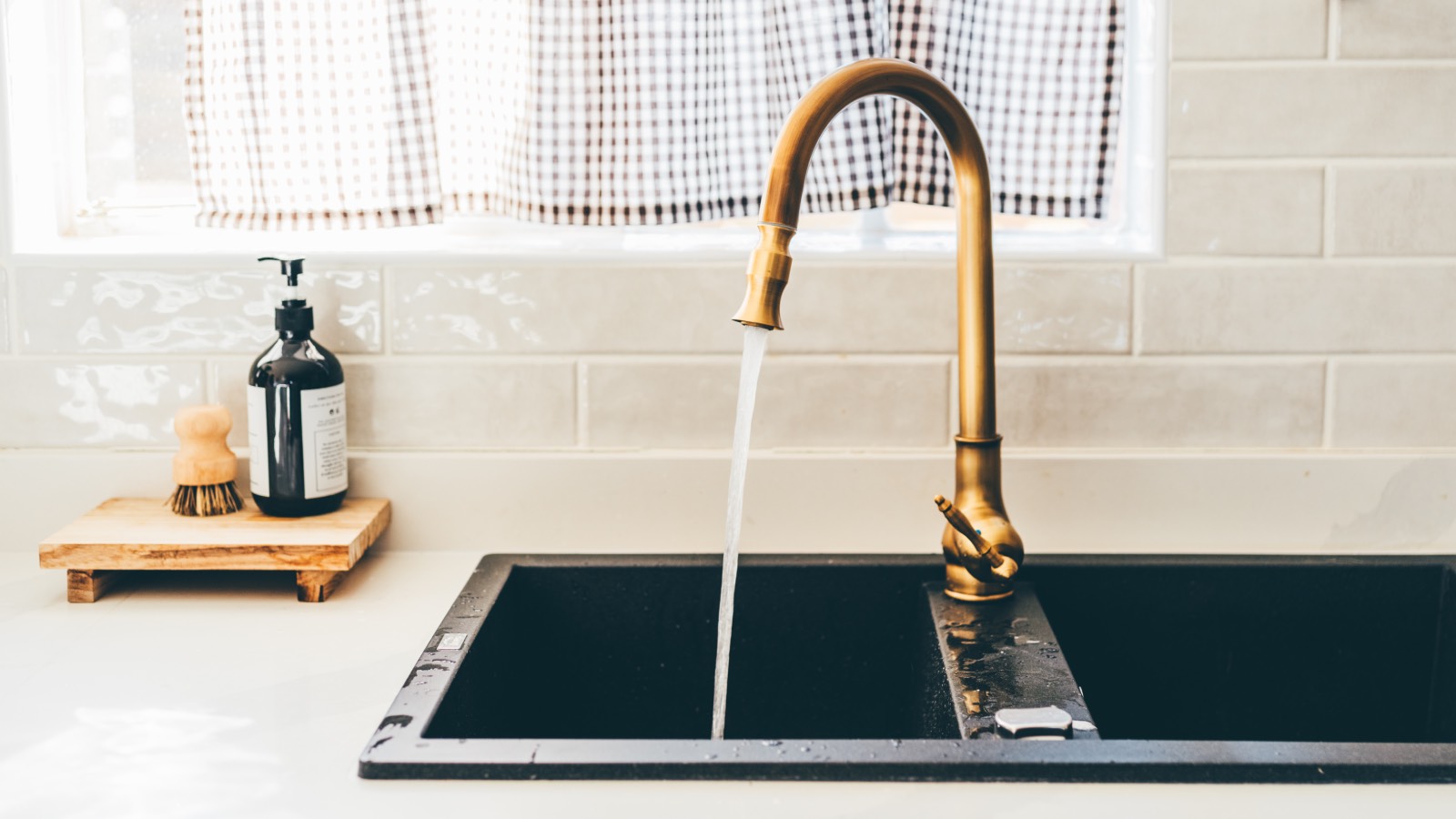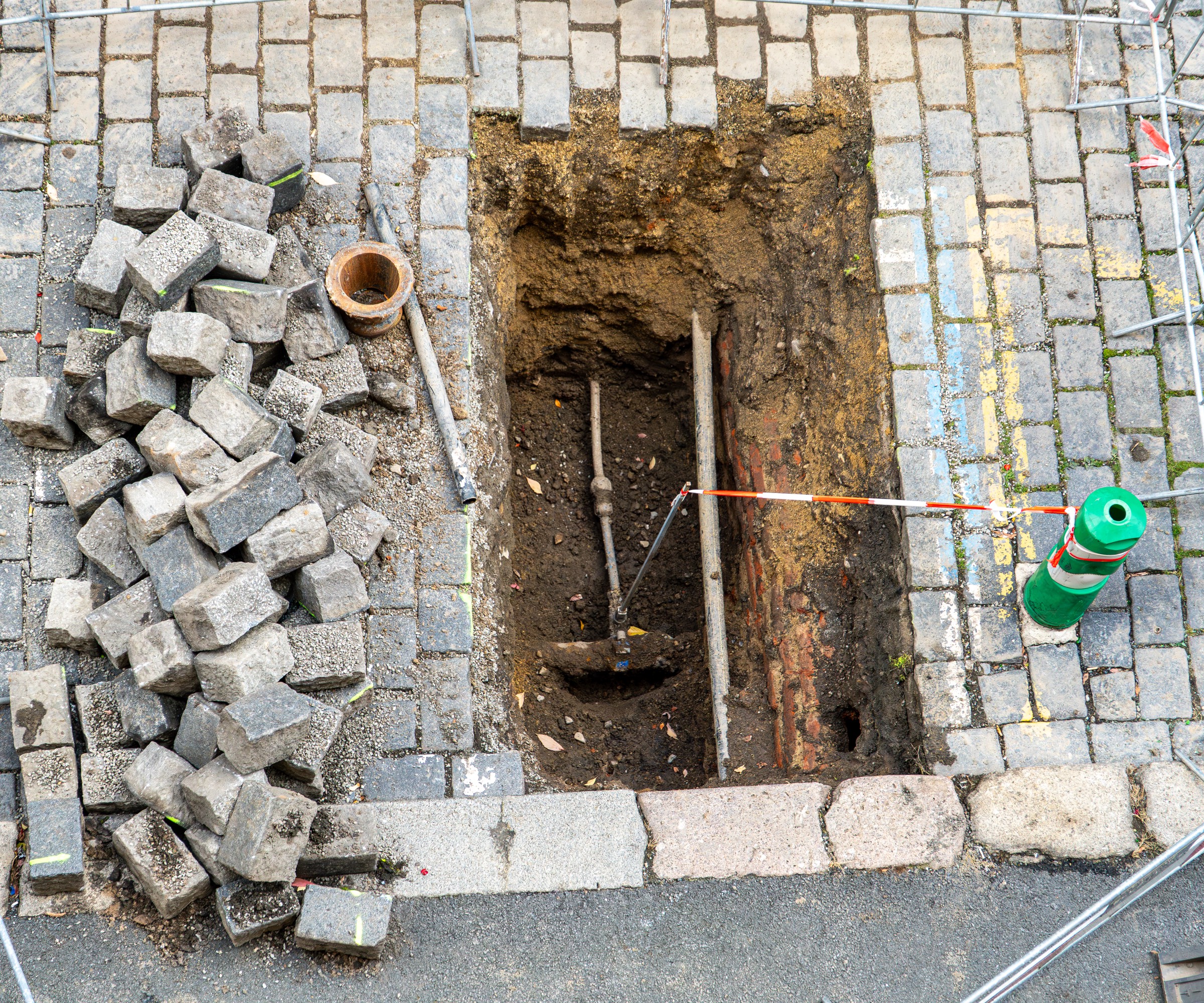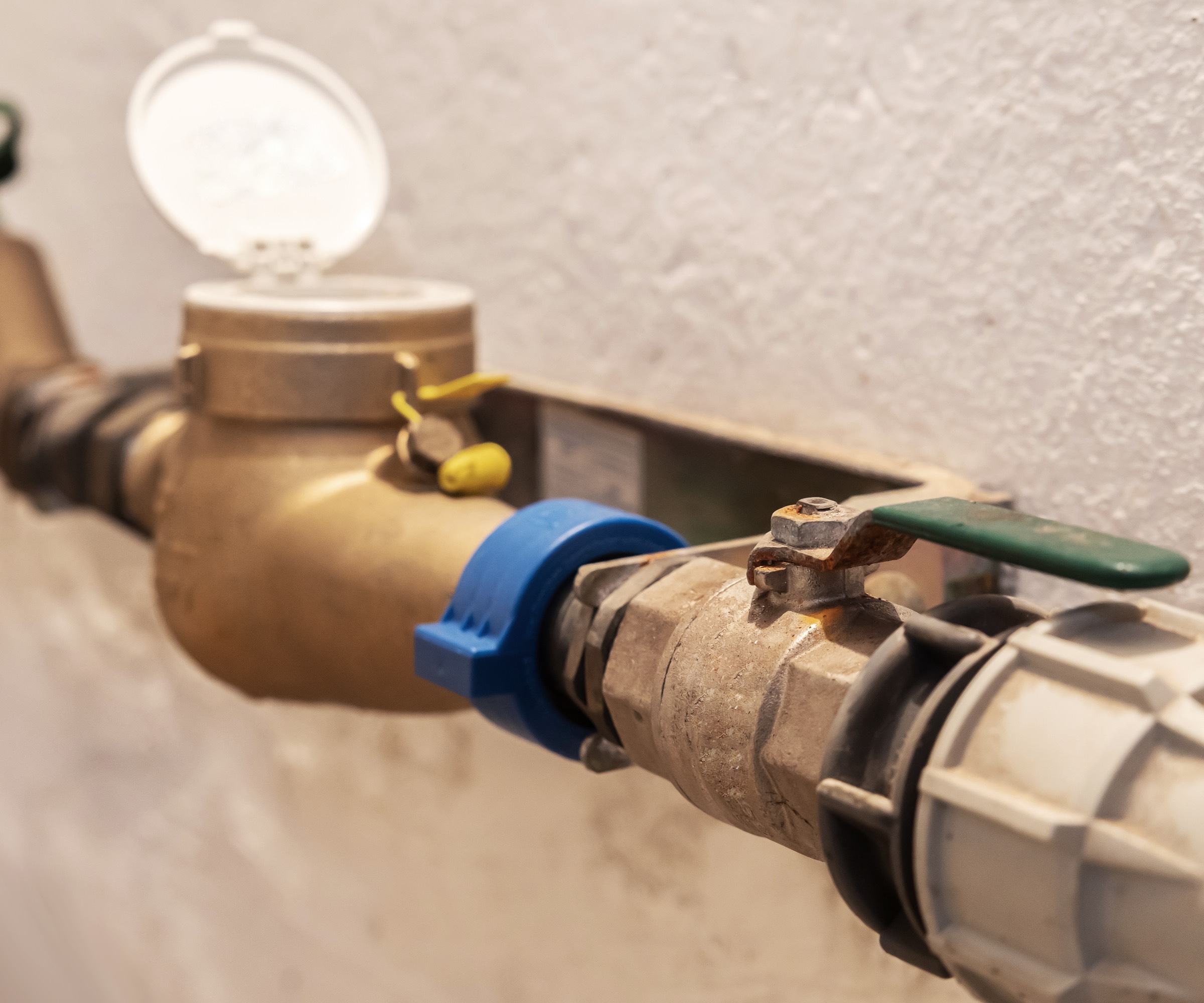Could your home still have lead pipes for your drinking water? How to find out and what to do
There's no need to panic. Just follow these simple steps to check your pipes and keep your drinking water safe.

Mention lead pipes and my first thought is of the Cluedo murder weapon – something from a bygone era when guests wandered through grand country houses with billiard rooms and libraries, plotting the demise of poor Dr Black. In other words, lead piping feels like a relic of centuries past – hardly something you’d expect to find lurking in modern homes.
And yet, you may still encounter them. "Before 1970, lead pipework was commonly used to connect properties to the mains water network," a spokesperson from the Government's Drinking Water Inspectorate told us. "The use of lead pipes has since been banned, however many older properties that have not been modernised are likely to have lead pipework underground and/or inside the building."
If you do have lead piping, tiny amounts of lead could be infiltrating your drinking water supply and causing long-term health damage. That's why it's always a good idea to check if you have any lead piping, particularly if you live in an older property. We've asked the experts to explain how to recognise lead pipes and the process of replacing them.

Jess Thomas is the managing director of Drainage Central and an expert in the drainage and plumbing industry. Jess continually provides valuable insights on a wide range of industry topics, and is dedicated to helping homeowners find effective solutions to their drainage problems.
The history of lead pipes
"Lead pipework was commonly used before the 1970s for incoming water supplies from the pavement into properties," explains Scott Hunter, co-owner of Hunter Heating Solutions and Checkatrade Plumber of the Year 2024. "In most cases, a single continuous lead pipe would run from the external stopcock in the pavement to the internal stopcock inside the house. This method was popular at the time because it required no joints, saved installation time, and the pipe’s flexibility made it easy to bend around corners."
"Lead was used traditionally as a material becuase it is tough but malleable and easy to bend and fashion into water pipes," adds Jess Thomas, managing director at Drainage Central. "Lead is also long lasting and resists the corrosion caused by water, and as it has a low melting point, it could even be fabricated on site if needed."

How to identify lead pipes in your home
"Most 1920-1970 houses will originally have an incoming cold mains lead supply," says Scott Hunter. "A good place to start is to locate the stopcock inside your property. In many cases, a lead mains pipe would run right up the stopcock. They are usually a dark grey pipe, around 18-25mm in diameter." You'll typically find your stockcock (also known as a stop tap) under your kitchen sink, or in a downstairs bathroom.
"You may also notice a distinctive, swollen, egg-shaped joint where the lead pipe transitions to copper or brass just before the stopcock," Scott points out. "If you gently scratch the surface of the lead pipe with a coin, a shiny metal should appear beneath it. On the other hand, if the pipe is covered in blue plastic, it’s likely that a newer MDPE pipe has already been installed."
"There are several ways you can check if your pipes are made from lead," agrees Jess, who explains what to look for:
- Colour: "Unpainted lead pipes will be dull grey in colour."
- Joints: "The joints of lead pipes are rounded and swollen where the pipes meet."
- Scratch test: "When a lead pipe is scratched, the metal underneath will be shiny and silver."
- Sound: -"When tapped, lead makes a dull thud, compared to copper or iron that will make a clear ringing sound."
- Building date: "Homes that were built before 1970 are more likely to have lead pipes than those built afterwards."
How does the lead in pipes contaminate the water?
The most common way for lead to contaminate your water supply is that lead from the pipework dissolves into the water whilst it stands in the pipe.
"A less common cause of lead in drinking water is the illegal use of lead-based solder to join sections of copper pipe," says the Drinking Water Inspectorate. "Lead solder is still permitted for use in closed central heating systems and mistakes occasionally happen whereby unqualified plumbers or householders use lead solder on drinking water pipes. Older brass fittings can also be a source of lead."
This contamination can be exacerbated by a few things, such as the condition of the lead pipework, and warmer temperatures – an increase in heat in the summer months can cause more lead to dissolve. Also, disturbing or working on lead pipes can also cause the concentration of lead in drinking water to temporarily increase.
Conversely, if you live in a hard water area, the limescale in the water can actually form a coating on the pipes, preventing the lead from dissolving into the water supply.
Bring your dream home to life with expert advice, how to guides and design inspiration. Sign up for our newsletter and get two free tickets to a Homebuilding & Renovating Show near you.

Health risks associated with lead exposure
According to the DWI, taking in these tiny lead deposits can cause mental impairments in unborn babies, infants and children, and impair kidney, heart and circulatory health in adults.
The NHS states on its NHS Inform website that: "exposure to lead can be harmful especially to unborn babies and young children. Infants and young children absorb a greater proportion of ingested lead than adults."
They state that the signs and symptoms in young children can include: "Irritability and fatigue, loss of appetite and weight loss, abdominal pain, vomiting, constipation, hearing loss, developmental delay and learning difficulties."
Symptoms in adults can include: "High blood pressure, abdominal pain, constipation, joint and muscle pain, pain, numbness or tingling of the extremities, headaches, fatigue and memory loss."
But they are at pains to point out that exhibiting these symptoms doesn't necessarily mean you have lead poisoning – and you should go to your GP if you have any concerns.
Testing your water for lead
If you suspect you have lead pipes, you should immediately contact your water supplier. They may be able to provide a free lead test and advise you on ways to reduce lead in your water supply. If you're in Scotland, for example, you can call the Scottish Water helpline on 0800 0778778 and organise for a water sample to be taken from your property free of charge. Or at Anglian Water you can call the Lead Advice Line on 0345 070 3445 to book a free lead test or use the online form.
Anglian Water tests for lead by taking four samples:
- A spot sample from your kitchen tap, without flushing it
- After running your tap for two minutes, a 'flushed sample' will be taken
- After waiting a further 30 minutes, a 'stagnation sample' is taken
- Lastly, they will take a fourth sample from your boundary box outside your property (if your property has one)
The samples are sent off to a lab, with the results usually expected within 10 working days. The water company will then advise next steps, including the replacement of pipework.
"Where a risk of lead exists, water companies sometimes treat the water with orthophosphate to reduce the problem significantly," says the Drinking Water Inspectorate. "None the less, particles of lead may build up in these older pipes and intermittently appear in tap water."
How to reduce lead exposure
"In the short term, flushing the pipework, before using for drinking or cooking, will help to reduce lead concentrations in the water," says the Drinking Water Inspectorate spokesperson we contacted. "This is because lead is picked up in the water as it comes into contact with the lead pipework and it has been standing in the pipework for a length of time, such as overnight, the lead concentration will be higher."
To clear your system, running around a washing-up bowl's worth of water should be enough. You can always use this water to clean your car, but not for watering plants or filling a bird bath. If you're still unsure, keep your fingers under the tap as it runs and wait for the temperature to change slightly – this signals that fresh and not standing water is coming from the mains.
"But the only sure way to remove lead from your water supply is to remove the lead pipework, including any lead solder, from your home and replace this with new plastic or copper pipework," say the Drinking Water Inspectorate.
What to do if you have lead pipes
"If you suspect that you have lead pipes, you should contact your local water board as a matter of urgency," says Jess at Drainage Central. "They will likely come out to test the pipes."
"If it turns out that your supply pipe is lead, most water suppliers offer a Lead Replacement Scheme," says Scott Hunter. You can usually apply for this online or by calling your supplier directly. However, you will normally need to arrange and pay for a contractor – ideally a WRAS Approved contractor – to install new pipework up to your property boundary. The water supplier will then connect it to the pipes under your nearest pavement."
Working with your local water utility company
"If the pipes are found to be lead, they may have a replacement scheme that can replace the pipes for free or at a reduced cost," reiterates Jess Thomas. However, this will vary depending on your supplier, and in researching this article, we found that very few 'full replacement' schemes are available (see below)
"The pipework between the water main and the property is called the supply pipe. This supply pipe is made up of the communication pipe and the service pipe," explains the Drinking water inspectorate. "The communication pipe connects into the water main and normally runs to the property boundary. It is the responsibility of the water supplier. The service pipe is the responsibility of the property owner and runs between the communication pipe and into the property, where it connects to the internal pipework."
While previously, you may have been able to access grants to replace both parts of the pipework, nowadays, most water companies will only fund and replace what's known as the 'communication pipe'. However, it's best to contact your water company directly to find out what support is available.

Affinity Water, for example, which supplies water to more than 3.9 million people across parts of Bedfordshire, Berkshire, Buckinghamshire, Essex, Hertfordshire, Surrey, London and Kent, is currently undertaking a targeted programme replacing the lead pipes in streets. However, like most water suppliers, it deems that the section of pipe from your boundary to your house and all internal pipes are your responsibility to replace.
"If you live within our supply area, Affinity Water advises that any replacement of a lead supply pipe should be carried out by an approved plumber and must comply with the Water Supply (Water Fittings) Regulations 1999," Eddie Lintott, Head of Water Quality & Scientific Services at Affinity Water told us.
"This is the legal duty of the owner, occupier, installer, or plumber to make sure the regulations are met and won’t have an impact on the quality of your water. For more advice on this, please visit Water Regs UK," he explains.
Selected lead pipe replacement schemes
For a limited period Bristol Water is offering to visit your home and check whether you have a lead supply pipe, and if it finds it is made of lead, replace it at no cost to you.
Northumbrian Water is also running a scheme whereby it will replace lead supply pipes running into your home for free. You will be contacted by email or letter automatically if you are eligible.
If your home is supplied by a lead pipe, Yorkshire Water will replace the pipework in the public highway under its lead renewal scheme. This covers the lead pipework from the public water main in your street up to the boundary of your property, and you'll need to apply online for the work to be done.
Severn Trent previously offered a full pipe replacement grant scheme, but stopped accepting new applications in January 2025. However, it will replace your connection pipe under its new Lead Replacement Scheme.
Thames Water will not replace what it calls 'supply pipes' but it will replace your connection pipe from your home's supply pipe to the mains, provided you meet its criteria To apply, you must fill in this online form.
United Utilities will replace the 'supply pipe' from your property boundary provided you meet certain criteria.

FAQs
How can I tell if I have lead pipes?
"First things first, do you know when your home was built? If it was built before 1970, you may have lead pipes in your plumbing system," says Eddie Lintott, Head of Water Quality & Scientific Services at Affinity Water. "You can check by looking at the section of pipe leading from your stop tap or water meter into your property."
"Lead pipes are normally dark grey in colour, but if gently scraped, shiny silver-coloured marks appear," Eddie explains. "They’re generally thicker than other metallic pipe materials and are also easier to scratch using a coin."
If you have lead pipes, there will be a swollen joint next to the stop tap connection. If you are unable to see any lead pipework, there may still be a hidden or underground section which is lead, or lead solder joining copper pipework.If you're unsure, ask an approved plumber to carry out this check for you.
We recommend using a Watersafe-approved plumber, who will follow Water Fittings Regulations, protecting your drinking water from contamination and costly mistakes.
Is it safe to drink water from lead pipes?
No. Lead has been proven to cause health issues – and is particularly dangerous to infants and pregnant women, causing issues with developmental and physical health.
How can I test my water for lead?
Typically, it's best that you contact your local water supplier and they will test your supply for you for free. You could ask your plumber to run a test, but they must use a certified laboratory-provided sample bottle.
Besides, if your plumber confirms there are traces of lead in your supply, it's likely your local water supplier will want to retest anyway. Therefore, it makes the most sense to contact the supplier in the first instance.
What should I do if my water contains lead?
If your water contains lead, you should immediately take short-term precautions such as running the tap for a few minutes before taking drinking water from it.
As soon as possible, contact your water supplier to find out what pipes they can replace and what grants are available, and then arrange for all lead pipes to be removed and substituted for safe copper and plastic pipes.
Does my water utility replace lead pipes?
"The support available to consumers varies according to their water supplier and they should contact them in the first instance if they would like to find out," says the Drinking Water Inspectorate spokesperson we contacted.
In researching this article however, the 'norm', at least in England, Scotland and Wales, seems to be that the water company will usually replace mains and connection pipes, but you will have to foot the bill for the service and internal pipes on your property.

Amy Cutmore is a UK-based journalist who has specialised in consumer tech and home improvement for two decades, covering everything from planning permission and paint colours to solar panels and soundbars.
She's been a writer, editor and head of content for sites including Ideal Home (as 'Girl About Tech'), Homes & Gardens, Livingetc, Saga Magazine, Grand Designs, The Guardian, The English Home, Tom's Guide, Expert Reviews and Trusted Reviews.
When she's not getting to grips with her overgrown garden or visiting washing machine factories (she can attest that they're not much different whether you're in Korea, Slovenia, Italy or Japan), you'll find her planning a new kitchen extension. Or boring people senseless about Formula 1 (and her triumphs in the F1 Fantasy League).
